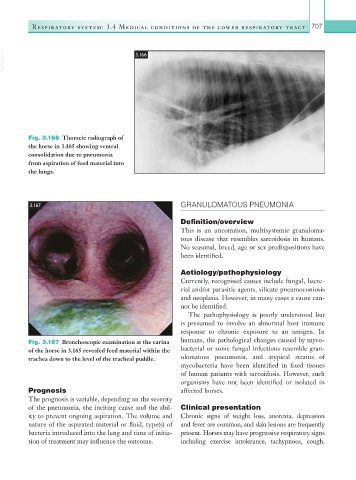Page 732 - Equine Clinical Medicine, Surgery and Reproduction, 2nd Edition
P. 732
Respir atory system: 3.4 Medical conditions of the lower respir atory tr act 707
VetBooks.ir 3.166
Fig. 3.166 Thoracic radiograph of
the horse in 3.165 showing ventral
consolidation due to pneumonia
from aspiration of feed material into
the lungs.
3.167 GRANULOMATOUS PNEUMONIA
Definition/overview
This is an uncommon, multisystemic granuloma-
tous disease that resembles sarcoidosis in humans.
No seasonal, breed, age or sex predispositions have
been identified.
Aetiology/pathophysiology
Currently, recognised causes include fungal, bacte-
rial and/or parasitic agents, silicate pneumoconiosis
and neoplasia. However, in many cases a cause can-
not be identified.
The pathophysiology is poorly understood but
is presumed to involve an abnormal host immune
response to chronic exposure to an antigen. In
Fig. 3.167 Bronchoscopic examination at the carina humans, the pathological changes caused by myco-
of the horse in 3.165 revealed feed material within the bacterial or some fungal infections resemble gran-
trachea down to the level of the tracheal puddle. ulomatous pneumonia, and atypical strains of
mycobacteria have been identified in fixed tissues
of human patients with sarcoidosis. However, such
organisms have not been identified or isolated in
Prognosis affected horses.
The prognosis is variable, depending on the severity
of the pneumonia, the inciting cause and the abil- Clinical presentation
ity to prevent ongoing aspiration. The volume and Chronic signs of weight loss, anorexia, depression
nature of the aspirated material or fluid, type(s) of and fever are common, and skin lesions are frequently
bacteria introduced into the lung and time of initia- present. Horses may have progressive respiratory signs
tion of treatment may influence the outcome. including exercise intolerance, tachypnoea, cough,

